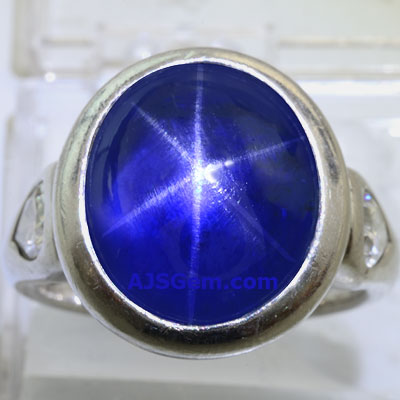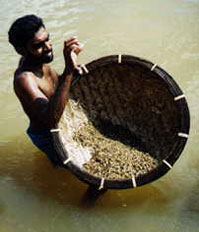
Blue Star Sapphire Information
Some rare natural sapphires exhibit a star-like phenomenon known as asterism. These gems contain intersecting needle-like inclusions (often the mineral rutile, a mineral composed primarily of titanium dioxide) that cause the appearance of a six-rayed star when viewed with a single overhead light source. To cause a star, the rutile needles need to form in parallel and tightly packed groups. The reflection off of each group of crystals forms a straight line which appears to float on the surface of the stone. There are always three groups of crystals which intersect at 60 degree angles from each other. The three lines formed connect in the center to form the appearance of a 6 ray star.
The presence of a star is one of the more remarkable phenomena encountered in the world of colored gemstones. This optical phenomenon is quite rare, being only found in a tiny percentage of the sapphires mined around the world. Star sapphires can occur in any color, but the most common colors are blue, black and pink. Since red corundum is referred to as ruby rather than sapphire, a red star would be be called a star ruby.
When looking to buy either a Blue Star Sapphire or a Pink Star Sapphire, remember that the value depends not only on the carat weight of the stone but also the body color, visibility and intensity of the asterism.
There are many reasons, but basically it comes down to two factors: value and choice.
When buying a loose gemstone instead of a pre-set stone, you can be sure you are getting the best value for your money. Loose gemstones are less expensive, a better value, and you can really see what you are paying for. The most important part of getting the right price and finding the best value is to first see what you're getting. A jewelry setting will hide the inclusions inside a gem, and can deepen or brighten its color. With a loose stone you can much more easily inspect the gem and see it for what it really is. In this way you can get a better idea of its true worth and be sure you are paying a fair price.
The second advantage of buying a loose gemstone is choice. You are free to pick the exact color, cut, shape and variety of the stone for the setting of your dreams, be it yellow gold, white gold, platinum or silver; prong set or bezel set. You can experience the joy of creating your very own, one-of-a-kind jewelry design. Choose from a variety of jewelry settings and styles to create a completely original presentation that will perfectly suit your individual gemstone and will be as unique as you are!

| Origin | Madagascar, Thailand, Sri Lanka, Ceylon, Burma, Burmese, Australia, India, Kenya, Tanzania, U.S.A., China |
|---|---|
| Color | All shades of blue and pink |
| Refractive Index | 1.759-1.778 |
| Chemical Composition | AL2 O3 |
| Hardness | 9 |
| Density | 4 |
| Crystal Structure | Trigonal |
| Zodiac Sign | Libra |
| Planet | Venus |
| Month | September |
| Anniversary | 5th and 45th |
Star sapphire's fascinating asterism is just one reason for this gemstone's popularity. As with all sapphire, they are also very durable, having a hardness of 9 on the Mohs scale. Sapphire has a specific gravity of 4.00, a refractive index of 1.76 - 1.78, and birefringence of 0.008. The refractive index (RI), measured using a refractometer, is an indication of the amount light rays are bent by a mineral. Birefringence is the difference between the minimum and maximum RI. When birefringence is high, light rays reflect off different parts of the back of a stone causing an apparent doubling of the back facets when viewed through the front facet.
The name sapphire comes from the Greek word "sapphirus", meaning "blue". However, sapphire gemstones come in many colors including pink, yellow, orange, green, black, color-change, purple, violet, light blue, and the rare orange-pink Padparadscha sapphire gems. Padparadscha comes from the Sinahalese word meaning "lotus color". Sapphires other than blue, pink, yellow, green and orange sapphire are usually called "natural fancy-color sapphire". Red hues result from traces of chromium. The greater the concentration of oxides the deeper the color.
Ovals, rounds, cushions and emeralds are the most common cuts for sapphire, due to the typical shape of sapphire rough. Other popular sapphire shapes include pears, briolettes, hearts and marquises. Star sapphire are always cut as cabochons in order to develop and properly display the star effect. Fibers or fibrous cavities within some gems reflect the light which causes a star to appear within the stone. A six-ray star sapphire has three sets of parallel fibers. Skilled cutters can sometimes create a 12-ray star sapphire but they are rare.
High quality star sapphires are not treated in any way. Some lower quality material is diffusion treated with rutile to improve the star. Recently we have seen some low quality star sapphires and star rubies which have been fracture-filled with lead-glass.


Legend has it that the first person to wear Sapphire was Prometheus, the rival of Zeus, who took the gemstone from Cacaus, where he also stole fire from heaven for man.
Known as the "Gem of Heaven", the ancient Persians believed Sapphires were a chip from the pedestal that supported the earth, and that its reflections gave the sky its colors.
Tradition holds that Moses was given the Ten Commandments on tablets of sapphire, making it the most sacred gemstone. Because blue sapphires represent divine favor, they were the gemstone of choice for kings and high priests. The British Crown Jewels are full of large blue sapphires, the symbol of pure and wise rulers.
The guardians of innocence, Sapphires symbolize truth, sincerity and faithfulness, and are thought to bring peace, joy and wisdom to their owners. In ancient times it was believed that when the wearer of a Sapphire faced challenging obstacles, the gem's power enabled them to find the correct solution.
In India it was believed that a Sapphire immersed in water formed an elixir that could cure the bite of scorpions and snakes. Alternatively, if it were worn as a talisman pendant, it would protect the wearer against evil spirits.
The following legend is Burmese in origin and highlights Sapphires‘ connection with faithfulness: “Eons ago Tsun-Kyan-Kse, a golden haired goddess with Sapphire blue eyes, presided lovingly over the temple of Lao-Tsun. Everyday, the temple‘s chief monk Mun-Ha, meditated before the golden goddess accompanied by his devoted companion, a green-eyed cat named Sinh. One day the temple was besieged by a group of terrible outlaws. When they threw Mun-Ha to the floor, Sinh leapt fiercely at the bandits, jumping up on his master‘s chest to protect him. The wrong doers fled screaming in fear, never to return and in gratitude for his courage, the golden goddess awarded Sinh with her Sapphire blue eyes. To this day, Sinh‘s ancestors guard over the temple.” The temple still stands and is populated by Siamese cat‘s with striking blue eyes (typically this breed has green eyes).
For hundreds of years Blue Sapphires were the popular choice for engagement and wedding rings.

